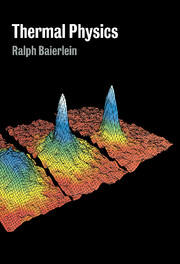Book contents
- Frontmatter
- Contents
- Preface
- 1 Background
- 2 The Second Law of Thermodynamics
- 3 Entropy and Efficiency
- 4 Entropy in Quantum Theory
- 5 The Canonical Probability Distribution
- 6 Photons and Phonons
- 7 The Chemical Potential
- 8 The Quantum Ideal Gas
- 9 Fermions and Bosons at Low Temperature
- 10 The Free Energies
- 11 Chemical Equilibrium
- 12 Phase Equilibrium
- 13 The Classical Limit
- 14 Approaching Zero
- 15 Transport Processes
- 16 Critical Phenomena
- Epilogue
- Appendix A Physical and Mathematical Data
- Appendix B Examples of Estimating Occupation Numbers
- Appendix C The Framework of Probability Theory
- Appendix D Qualitative Perspectives on the van der Waals Equation
- Index
14 - Approaching Zero
Published online by Cambridge University Press: 05 June 2012
- Frontmatter
- Contents
- Preface
- 1 Background
- 2 The Second Law of Thermodynamics
- 3 Entropy and Efficiency
- 4 Entropy in Quantum Theory
- 5 The Canonical Probability Distribution
- 6 Photons and Phonons
- 7 The Chemical Potential
- 8 The Quantum Ideal Gas
- 9 Fermions and Bosons at Low Temperature
- 10 The Free Energies
- 11 Chemical Equilibrium
- 12 Phase Equilibrium
- 13 The Classical Limit
- 14 Approaching Zero
- 15 Transport Processes
- 16 Critical Phenomena
- Epilogue
- Appendix A Physical and Mathematical Data
- Appendix B Examples of Estimating Occupation Numbers
- Appendix C The Framework of Probability Theory
- Appendix D Qualitative Perspectives on the van der Waals Equation
- Index
Summary
This chapter explores in greater depth the connections among entropy, temperature, and energy transfer by heating (or cooling). The sections are diverse but related, albeit loosely. The first section develops a general expression for entropy in terms of probabilities. The next section provides an example and also prepares the ground for section 14.3, which discusses a classic method of reaching low temperatures. The section entitled “The Third Law of Thermodynamics” explores the constraints on methods for approaching absolute zero. In section 14.6, we discover that temperatures numerically below absolute zero have been produced in the lab, and we explore that context. Finally, the last three sections reflect on the notions of temperature, heating, and entropy.
In short, the chapter's title, “Approaching zero,” highlights the central four sections, sections 14.3 to 14.6. The sections that precede and follow those sections are loosely related to the central sections and are also valuable in their own right.
Entropy and probability
Chapter 2 used the idea of multiplicity and its evolution to state the Second Law of Thermodynamics. A quantitative study of how multiplicity changes during a slow isothermal expansion led to entropy, defined as S ≡ k In (multiplicity). In chapter 5, we used the entropy concept to derive the canonical probability distribution; thereby we introduced an explicit expression for probabilities at thermal equilibrium. Now we complete the loop by learning how the probabilities can be used to calculate the entropy.
- Type
- Chapter
- Information
- Thermal Physics , pp. 327 - 355Publisher: Cambridge University PressPrint publication year: 1999

